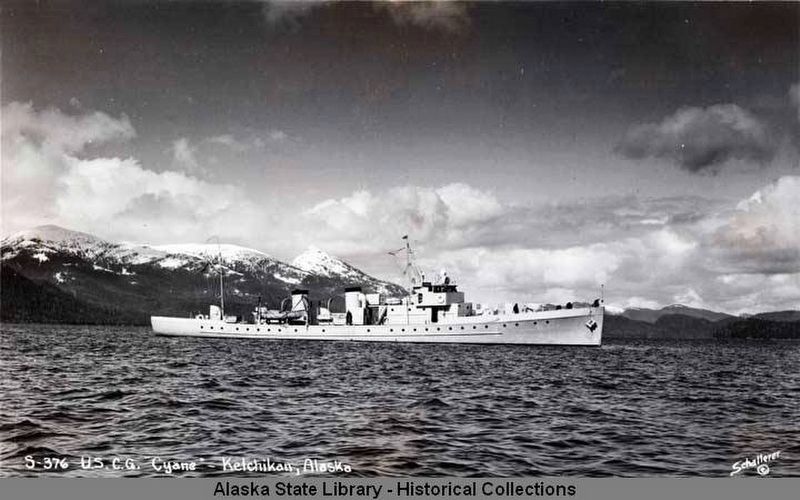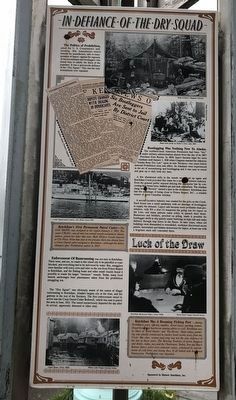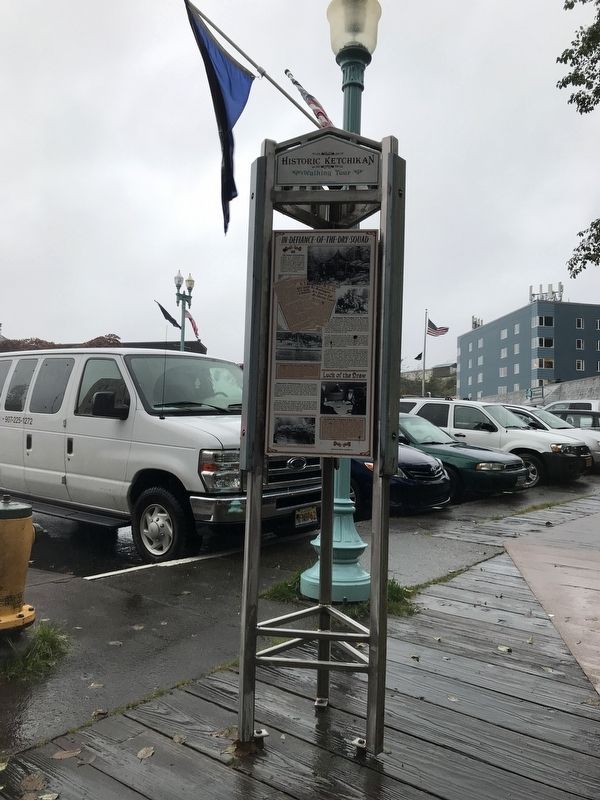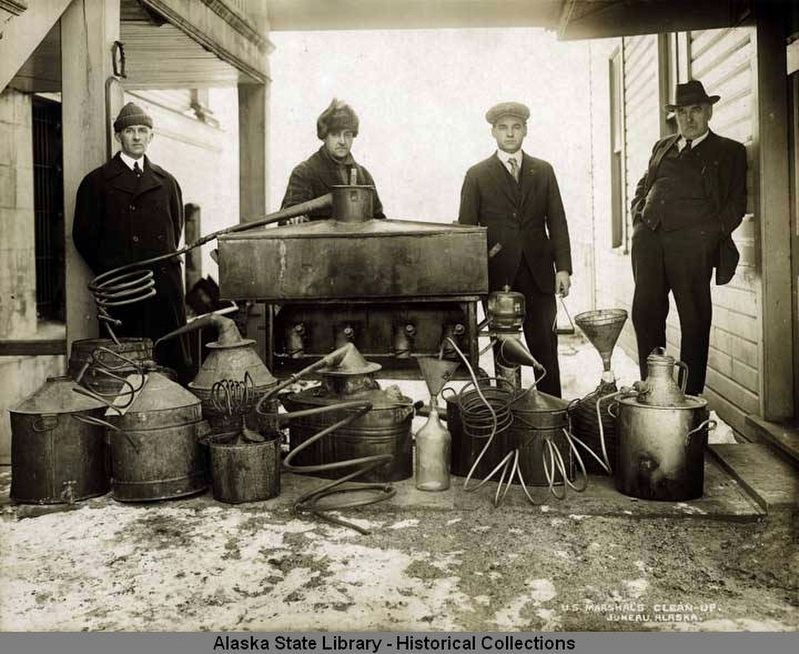Ketchikan in Ketchikan Gateway Borough, Alaska — Northwest (North America)
In Defiance of the Dry Squad
Inscription.
The Politics of Prohibition pitted the U. S. Constitution's well-meaning 18th Amendment — which banned the manufacture, sale or transportation of liquor — against the ingenuity of the moonshiners and bootleggers who found ways to satisfy the thirst of the populace. It was a nationwide defiance of the “Dry Squad.” This was the only Amendment ever repealed.
Bootlegging Was Nothing New To Alaska
The northern-most American Possession had been “dry” under military administration almost from the day of its 1867 Purchase from Russia. In 1899, liquor became legal for most Alaskans until January 1, 1918 when Congress enacted the infamous “Alaska Bone Dry Law” upon its new Territory — two years before national Prohibition went into effect. So Alaskans were experienced in the art of moonshining and bootlegging and it was easy to retool and gear up to defy both dry laws.
A few abandoned stills in the woods were fired up again and Ketchikan Creek provided fine water for a microhomebrew industry. Even the general public enjoyed defying the unpopular law by concocting their home brew, bathtub gin and rank moonshine. The Alaskan slang word “hooch” earned a spot in the dictionary. Ketchikan also had the advantage of being close to Prince Rupert, B.C., a reliable source of good Canadian whiskey.
A second lucrative industry was created for the girls on the Creek. Each house was a small speakeasy with no shortage of bootleggers to supply the demand. Liquor sale became more profitable than prostitution, with 50¢ a shot (½ teaspoon) the going rate for liquor on the Line, and many patrons came solely to quench their thirst. Businesses and brothels, perched on piling, made it possible for bootlegger skiffs to slip quietly under buildings at high tide and make delivery through trap doors in the floors. In later years, when old buildings were dismantled or remodeled, workmen discovered secret panels, dumbwaiters and hidden storerooms for liquor, at least one with a forgotten stash still concealed there.
Enforcement of rumrunning was not easy in Ketchikan. There were, and are, no roads to this island city to be patrolled or roadblocked, and everything had to be delivered by water. But smugglers were familiar with every cove and inlet on the run from Prince Rupert to Ketchikan, and the fishing boats and other small vessels found it possible to evade the larger “revenuer” vessels. Today, many local remote anchorages bear place names taken from the prohibition smuggling era.
The “Dry Squad” was obviously aware of the extent of illegal rumrunning to Ketchikan, Alaska's largest city at the time, and the gateway to the rest of the Territory. The first enforcement vessel
to arrive was the Coast Guard Cutter Bothwell, which was sent to patrol the area in June, 1921. The vessel mysteriously departed the day after its arrival, apparently detoured to other duty.
[Sidebars]
Ketchikan's First Permanent Patrol Cutter The CGC Smith was assigned to the region January 1, 1923. The cutter Cygan, one of only two armed vessels assigned to Alaska waters, joined her later that year. Both 110-foot vessels moored at City Float. From that year to the present, there has always been a Coast Guard cutter assigned to Ketchikan-although the duties changed after Prohibition ended in 1933.
Ketchikan was a booming fishing port during Prohibition years, offering supplies, vessel repair, sporting women, illegal booze and backroom gaming tables as well. Ketchikan saw its share of “card sharks” and “tin-horns”. High-stakes gambling was usually conducted in smoky hotel rooms away from the Creek. But wine, women and song was not the only defiance of the law in those years. The Roaring Twenties of movie flappers and sheiks, radio, jazz and the Charleston, Turkey Trot and Black Bottom dance styles were national crazes, enhanced by refreshments of cold brew and strong shot. It all ended with the Great Depression. Prohibition was repealed.
Captions
(Left, top to bottom)
• Ketchikan,

Otto C. Schallerer/Alaska State Library, Capt. Lloyd H. (Kinky) Bayers Collection
3. U.S. Coast Guard Cutter Cyane
It was designed to intercept "rum runners" during prohibition, but prohibition ended before she was put into service. However, her design proved to be effective for other Coast Guard missions.
• Coast Guard patrol cutters, City Float — circa 1923. Tongass Historical Society
• Creek Street — circa 1930s. William Lattin/Tongass Historical Society
(Right side, top to bottom)
• ‘Not in Kentucky but Alaska!’ Winter & Pond/C. Waugaman Collection
• Home brew picnic at Traitor's Cove — July 1924. Tongass Historical Society
• Ketchikan backroom poker — circa 1930s. Milone Studio/Tongass Historical Society
Erected by Historic Ketchikan, Inc.
Topics. This historical marker is listed in these topic lists: Industry & Commerce • Law Enforcement • Waterways & Vessels. A significant historical date for this entry is January 1, 1918.
Location. 55° 20.538′ N, 131° 38.568′ W. Marker is in Ketchikan, Alaska, in Ketchikan Gateway Borough. Marker can be reached from the intersection of Creek Street and Totem Way. Marker is in parking lot next to the main entrance to Creek Street, a pedestrian-only area. Touch for map. Marker is at or near this postal address: 4 Creek Street, Ketchikan AK 99901, United States of America. Touch for directions.
Other nearby markers. At least 8 other markers are within walking distance of this marker. 'Cat' Houses & Sporting Women (here, next to this marker); Star House (within shouting distance of this marker);
Chief Johnson Totem Pole (within shouting distance of this marker); Ketchikan Shingle Mill (within shouting distance of this marker); Sea and Skyline (within shouting distance of this marker); Carving a Place in History (within shouting distance of this marker); Crossing a Frontier (within shouting distance of this marker); Chief Kyan Totem Pole (about 300 feet away, measured in a direct line). Touch for a list and map of all markers in Ketchikan.
Also see . . .
1. Prohibition attempted to ban alcohol a century ago. Alaska enacted a ban two years earlier. Neither one worked. — Retrospective by Dave Kiffer in online news site Stories in the News, posted January 26, 2019. (Submitted on September 18, 2021, by Duane and Tracy Marsteller of Murfreesboro, Tennessee.)
2. The Death of a Snitch. Mystery still surrounds the death of David I. Chess, a Seattle wrestler known in Ketchikan as Tiny Walker, whose body was found not long after he helped revenue officers intercept bootlegged booze a century ago. By Dave Kiffer in online news site Stories in the News, posted July 18, 2021. (Submitted on September 18, 2021, by Duane and Tracy Marsteller of Murfreesboro, Tennessee.)
3. “Black Matt” Berkovich and Son Nick: A Ketchikan Story. Considered one of Ketchikan's most notorious bootleggers, Black Matt shot and killed a chief prosecution witness against him in broad daylight — then committed suicide. His son, however, was a much different man. Retrospective by Louise Brinck Harrington in online news site Stories in the News, posted August 19, 2015. (Submitted on September 18, 2021, by Duane and Tracy Marsteller of Murfreesboro, Tennessee.)
Credits. This page was last revised on January 2, 2022. It was originally submitted on September 18, 2021, by Duane and Tracy Marsteller of Murfreesboro, Tennessee. This page has been viewed 450 times since then and 27 times this year. It was the Marker of the Week January 2, 2022. Photos: 1, 2, 3, 4. submitted on September 18, 2021, by Duane and Tracy Marsteller of Murfreesboro, Tennessee.


